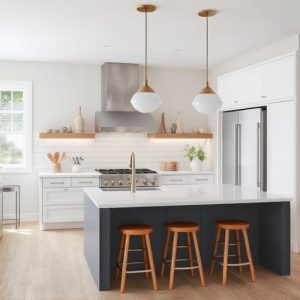Understanding your current kitchen layout is crucial for any renovation project. Identify bottlenecks, appliance placement issues, and storage inefficiencies to make informed decisions. Maximize space utilization with creative storage solutions like floor-to-ceiling cabinets and pull-out drawers, transforming cramped areas into functional culinary hubs. Optimize work triangles for seamless meal preparation and cleaning routines. Incorporate smart appliances and digital integration for enhanced convenience. Rethink seating arrangements with standing counters and compact seating to promote active cooking. Blend form and function through customization options, creating an aesthetically pleasing kitchen that caters to your daily needs and personal style.
Redesigning your kitchen layout is a powerful way to transform your cooking experience. This article explores how optimizing space, workflow, and technology can make your kitchen more functional and enjoyable. From identifying problem areas in your current setup to incorporating smart appliances and ergonomic designs, discover creative solutions for a seamless kitchen renovation. Learn how to create a personalized space that caters to your needs, making meal preparation and cleanup a breeze.
- Understanding Your Current Kitchen Layout: Identifying Pain Points
- Maximizing Space Utilization: Creative Solutions for Efficient Storage
- Streamlining Work Triangles: Designing for Seamless Food Preparation and Cleaning
- Incorporating Technology: Smart Appliances and Digital Integration Ideas
- Enhancing Ergonomics: Comfortable Standing and Seating Arrangements
- Finishing Touches: Aesthetics and Customization for a Personalized Kitchen
Understanding Your Current Kitchen Layout: Identifying Pain Points
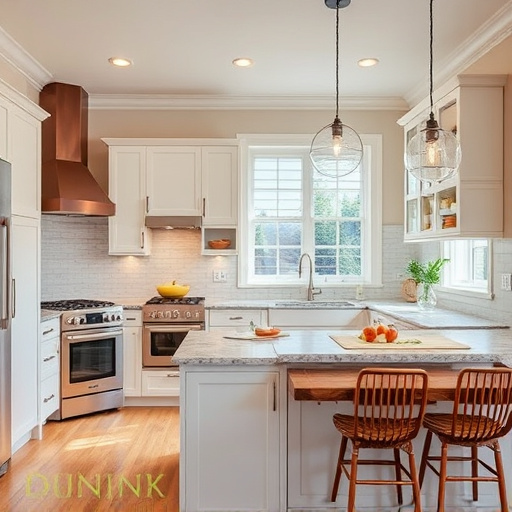
Understanding your current kitchen layout is a crucial step in any kitchen renovation project. Start by observing how you and your family currently use the space. Identify areas that cause bottlenecks or inefficiencies, such as traffic jams at the sink or fridge, or a lack of counter space for meal preparation. Look at the placement of appliances—is the stove easily accessible for cooking, and is the dishwasher close to the sink for convenience? Pay attention to storage solutions too; are cupboards and drawers organised effectively, or do you struggle to find what you need?
By pinpointing these pain points, you can make informed decisions about how to rearrange your kitchen. This may involve reconfiguring appliances, adding new storage units, or even removing walls to create a more open and functional layout. A well-planned kitchen redesign can transform your cooking experience, making daily routines smoother and more enjoyable—a key aspect of successful kitchen renovations.
Maximizing Space Utilization: Creative Solutions for Efficient Storage
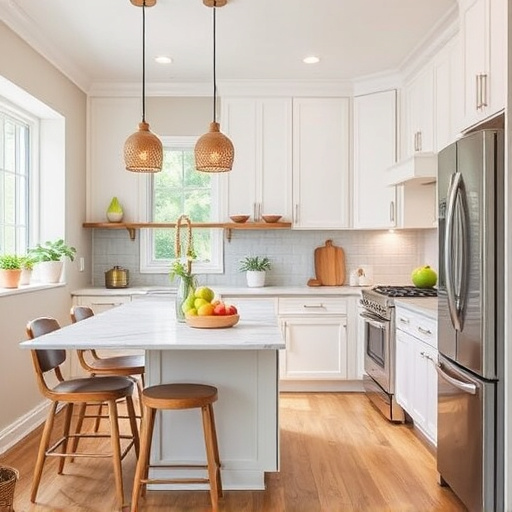
Redesigning your kitchen layout can significantly enhance both its flow and functionality, making everyday tasks smoother and more enjoyable. One key aspect to consider is maximizing space utilization, especially in smaller kitchens. Creative storage solutions are a game-changer here. For instance, installing floor-to-ceiling cabinets can provide ample storage for dishes, cookware, and pantry items, ensuring everything is organized and easily accessible. Overhead racks or pull-out drawers can also be utilized to store less frequently used items, keeping the work areas clear and clutter-free.
Furthermore, integrating clever design elements like sliding baskets, under-counter shelves, or suspended trays can make the most of dead spaces. These solutions enable efficient storage of small appliances, utensils, or even cleaning supplies, ensuring they’re within reach yet don’t obstruct counter space. When planning kitchen renovations, focusing on these creative storage tactics can transform a cramped area into a functional and inviting culinary hub.
Streamlining Work Triangles: Designing for Seamless Food Preparation and Cleaning

In kitchen renovations, streamlining work triangles is a key strategy for enhancing both flow and functionality. The three primary work areas—preparation, cooking, and cleaning—should be arranged in a logical, triangular pattern to minimize unnecessary steps and optimize movement. This design ensures that ingredients, utensils, and appliances are within easy reach, facilitating seamless food preparation and cleaning routines. By optimizing this triangle, you create a more efficient workspace that reduces time spent navigating the kitchen, allowing for a smoother and more enjoyable culinary experience.
When redesigning your kitchen layout, consider the sequence of tasks involved in meal preparation. For instance, positioning the refrigerator, stove, and sink in a way that mirrors common cooking routines can significantly improve workflow. A well-planned work triangle ensures that you move efficiently between these areas, making the most of your time and energy while preparing meals. This streamlined approach not only enhances productivity but also contributes to a more organized and stress-free kitchen environment.
Incorporating Technology: Smart Appliances and Digital Integration Ideas
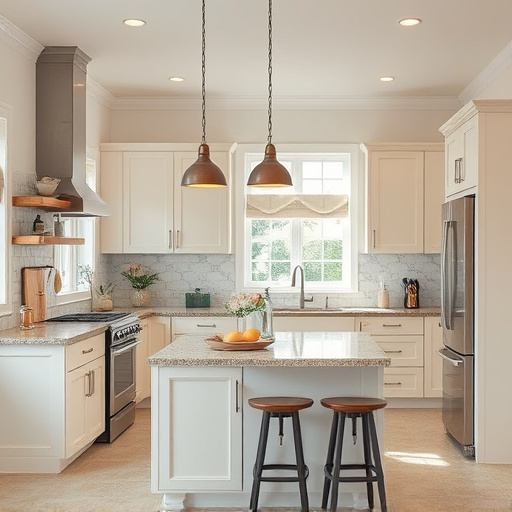
In today’s digital era, kitchen renovations often incorporate smart appliances and digital integration ideas that enhance functionality. From voice-activated ovens to app-connected refrigerators, these innovations streamline tasks and improve overall efficiency in the heart of your home. Imagine adjusting lighting and temperature settings with a simple voice command or receiving real-time alerts about food expiration dates directly on your smartphone.
Such technological advancements not only make kitchen tasks more convenient but also contribute to better flow and organization. Digital displays integrated into countertops can provide quick recipes, while smart cabinets offer touch-sensitive controls for automated storage systems. These features not only add a modern aesthetic but also ensure that your kitchen remains a centralized hub for cooking, entertainment, and family interaction.
Enhancing Ergonomics: Comfortable Standing and Seating Arrangements
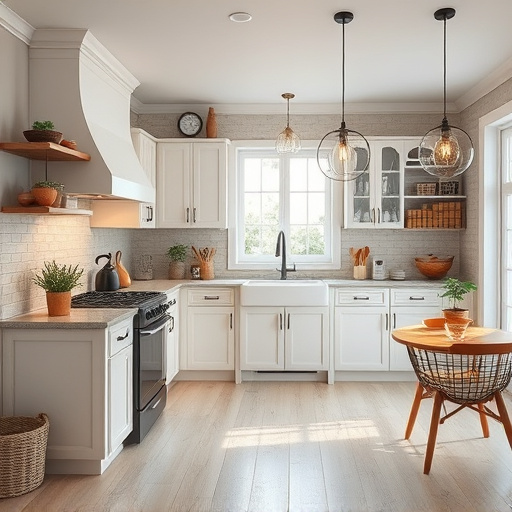
Redesigning your kitchen layout isn’t just about aesthetics; it’s an opportunity to enhance ergonomics and create a more comfortable space for daily use. One of the key aspects to consider is the arrangement of standing and seating areas. In many traditional kitchens, the focus has been on sitting down while preparing meals, leading to clunky traffic flow and inefficiencies. A modern approach encourages integrating comfortable standing counters and compact seating solutions that don’t obstruct movement.
This shift promotes a more active kitchen experience, reducing strain on your body. By incorporating height-adjustable countertops, you can create a versatile space that accommodates various tasks—from meal prep to casual dining. Additionally, strategically placed bar stools or built-in benches ensure that multiple people can engage in culinary activities together while maintaining a smooth flow of traffic between the stove, sink, and refrigerator. Such thoughtful design choices make kitchen renovations not just an upgrade but a healthier and more enjoyable part of your daily routine.
Finishing Touches: Aesthetics and Customization for a Personalized Kitchen
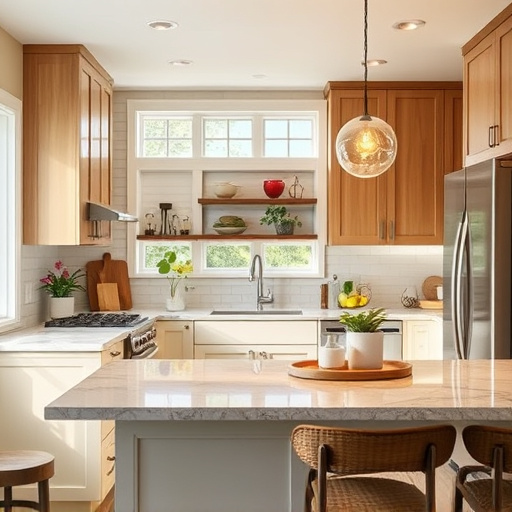
When redesigning your kitchen layout, don’t underestimate the power of finishing touches. While functionality and flow are paramount, aesthetics play a significant role in creating a space that feels both welcoming and personal. Customization options allow you to infuse your unique style into every detail, from hardware and backsplashes to cabinet handles and countertops.
Kitchen renovations offer an excellent opportunity to blend form and function seamlessly. Consider the overall design aesthetic—modern, rustic, minimalist, or eclectic—and choose finishing elements that complement it. Incorporate accents that reflect your personality and preferences, whether through colorful appliances, a statement island, or bespoke tile work. By adding these personalized touches, you’ll transform your kitchen into a truly special space where you can enjoy cooking and entertaining with friends and family.
Redesigning your kitchen layout is a powerful way to enhance both functionality and flow, transforming it into a truly personalized space. By understanding your current setup, maximizing every inch of available space, and incorporating thoughtful design principles, you can create a kitchen that supports your daily routines and elevates your culinary experiences. Whether it’s streamlining work triangles for efficient food prep or integrating smart appliances for modern convenience, these strategies contribute to a successful kitchen renovation. So, why wait? Start planning today and unlock the full potential of your dream kitchen.
